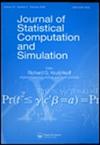可处理的斜正态近似通过匹配
IF 1.2
4区 数学
Q4 COMPUTER SCIENCE, INTERDISCIPLINARY APPLICATIONS
Journal of Statistical Computation and Simulation
Pub Date : 2023-11-07
DOI:10.1080/00949655.2023.2277885
引用次数: 0
摘要
摘要许多近似贝叶斯推理方法为了逼近后验分布,都采用了特定的参数形式。高斯分布为这类方法提供了方便的密度;例子包括拉普拉斯、惩罚类似然、高斯变分和期望传播方法。不幸的是,这些都忽略了潜在的后偏性。Durante et al.[偏斜Bernstein-von Mises定理和偏模态近似;2023. ArXiv预印本ArXiv:2301.03038。]使用偏模态(SM)近似解决了这个问题,并在理论上由偏斜的伯恩斯坦-冯·米塞斯定理证明了这一点。然而,SM近似在可追溯性和存储成本方面可能不切实际,并且只使用局部后验信息。我们介绍了各种基于匹配的近似方案,使用标准斜态分布来解决这些问题。实验比较了这种斜态-正态匹配方法(作为独立近似和事后偏度调整)与SM和现有高斯近似的性能。我们表明,对于小尺寸和中等尺寸,斜正态匹配可以比这些其他方法更准确。对于事后的偏度调整,这在额外的计算时间上花费很少。关键词:近似贝叶斯推断匹配模拟偏正态分布披露声明作者确认没有相关的财务或非财务竞争利益需要报告。John T. Ormerod的工作得到了澳大利亚研究委员会发现项目资助(DP210100521)的支持。本文章由计算机程序翻译,如有差异,请以英文原文为准。
Tractable skew-normal approximations via matching
AbstractMany approximate Bayesian inference methods assume a particular parametric form for approximating the posterior distribution. A Gaussian distribution provides a convenient density for such approaches; examples include the Laplace, penalized quasi-likelihood, Gaussian variational, and expectation propagation methods. Unfortunately, these all ignore potential posterior skewness. The recent work of Durante et al. [Skewed Bernstein-von Mises theorem and skew-modal approximations; 2023. ArXiv preprint arXiv:2301.03038.] addresses this using skew-modal (SM) approximations, and is theoretically justified by a skewed Bernstein-von Mises theorem. However, the SM approximation can be impractical to work with in terms of tractability and storage costs, and uses only local posterior information. We introduce a variety of matching-based approximation schemes using the standard skew-normal distribution to resolve these issues. Experiments were conducted to compare the performance of this skew-normal matching method (both as a standalone approximation and as a post-hoc skewness adjustment) with the SM and existing Gaussian approximations. We show that for small and moderate dimensions, skew-normal matching can be much more accurate than these other approaches. For post-hoc skewness adjustments, this comes at very little cost in additional computational time.Keywords: Approximate Bayesian inferencemoment matchingsimulationskew-normal distribution Disclosure statementThe authors confirm that there are no relevant financial or non-financial competing interests to report.Additional informationFundingThe work of John T. Ormerod was supported by an Australian Research Council Discovery Project Grant (DP210100521).
求助全文
通过发布文献求助,成功后即可免费获取论文全文。
去求助
来源期刊

Journal of Statistical Computation and Simulation
数学-计算机:跨学科应用
CiteScore
2.30
自引率
8.30%
发文量
156
审稿时长
4-8 weeks
期刊介绍:
Journal of Statistical Computation and Simulation ( JSCS ) publishes significant and original work in areas of statistics which are related to or dependent upon the computer.
Fields covered include computer algorithms related to probability or statistics, studies in statistical inference by means of simulation techniques, and implementation of interactive statistical systems.
JSCS does not consider applications of statistics to other fields, except as illustrations of the use of the original statistics presented.
Accepted papers should ideally appeal to a wide audience of statisticians and provoke real applications of theoretical constructions.
 求助内容:
求助内容: 应助结果提醒方式:
应助结果提醒方式:


